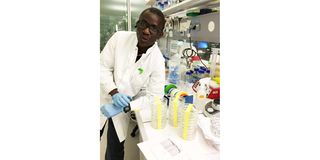Kenyan researcher finds potential cure for tuberculosis

Dr Sospeter Njeru has also done work on stem cells, aging, cancer and immunology.
What you need to know:
- Tuberculosis is the leading cause of mortality from a single infectious agent.
- He used an ethnobotanical and ethnopharmacology approach to settle on studying the plant.
A Kenyan researcher working in Germany has published groundbreaking research findings of discovery of a potential cure for tuberculosis. The prospective cure is drawn from a local herb. This fete may alter the treatment and management of the disease that claims the lives of about one million people in the world annually.
This discovery by Dr Sospeter Njeru will strengthen the importance of sourcing the discovery of new affordable drugs from plants and is a major leap for the herbal medicine sector.
His research, which was published last month by CellPress (Heliyon Journal) was based on the medicinal qualities of Aspilia pluriseta, a herb that is common in many parts of Kenya.
It is referred to as muuti by the Mbeere, Embu, and Kikuyu communities, while the Akamba refer to it as wuti, ol-oiyabase by the Maasai and shilambila by the Abaluhya.
Government subsidises
“The current drugs administered are very expensive (Most patients in Kenya afford them because the government subsidises their cost) and their effectiveness is threatened by development of drug resistance. Additionally, these drugs are taken as a combination of up to three different drugs, and this is not easy for many people to adhere to, not mentioning the side effects associated with them. There is, therefore, a great demand for cheaper and effective drugs which have less propensity of losing their treatment activity due to drug resistance,” Dr Njeru told Higher Education.
The research findings of the team led by Dr Njeru show that extracts from the Aspilia pluriseta herb have the capacicity to completely kill the disease-causing bacteria. The title of the paper is Antimicrobial activity, phytochemical characterisation and gas chromatography-mass spectrometry analysis of Aspilia pluriseta Schweinf extracts. He has co-authored it with his student, Jackson M. Muema, of the Department of Biochemistry, Jomo Kenyatta University of Agriculture and Technology.
“We used a method whereby every growing tuberculosis bacteria would be represented by a fluorescent count that would be given a quantitive value/growth unit of zero (for no growth) to 400 (for absolute growth as if there is no drug). We set a cut-off point of 100 growth units. Any sample which gave 100 units and below was considered as having strong potential as a drug candidate. Surprisingly, most of our samples completely killed the tuberculosis bacteria giving zero growth unit,” explains Dr Njeru.
The researcher, who is currently a post-doctoral scientist at Paul-Erlich Institute, division of immunology in Langen (Hessen) – Germany is a lecturer of biochemistry and biomedical sciences at the Department of Biochemistry at Kisii University.
“Tuberculosis is the leading cause of mortalities from a single infectious agent, which claimed the lives of over one million people, besides making an additional over 10 million people ill in 2018,” he comments.
Mycobacterium tuberculosis
He used an ethnobotanical and ethnopharmacology approach to settle on studying the plant. He said that the inspiration to study the herb came from its use by members of his community to treat various illnesses. The approach involves gleaning information from herbalists and community members on how specific plants are used.
“The Mbeere people have been using this plant for ages in managing ‘strong coughs’ and ‘complicated respiratory infections’. I hypothesised that these could be alluded to TB, and our results show very specific killing activity toward Mycobacterium tuberculosis (which causes TB), and not much killing activity against other bacteria such as Klebsiella pneumonia that is often associated with coughs,” he explained.
He adds that the publication of the findings is only the first step towards commercialisation of his work. He plans to do further investigations to identify and patent the active biomolecules in the plant. “I’m hopeful that I will be able to possibly partner with interested pharmaceutical companies and if not I may consider establishing a small biotech company that can midwife commercialisation of the identified active biomolecules.”
He is targeting both the pharmaceutical and herbal medicine industries to develop a drug using the knowledge he has so far discovered. He said that another aspect of the research which is under review in BMC Research Note Journal is about the biosafety of the herb.
Dr Njeru hastens to warn that it is still early to use extracts from the herb to treat patients as more research is needed, adding that the most important aspect of the research was to scientifically validate the activity and the safety of the samples.
Herbal medication
“Many people have poisoned themselves while using herbal medication, therefore we demonstrated that the plant was active and safe to use.”
The bulk of the study was funded through a grant he won from Internation Foundation for Science (IFS), Stockholm-Sweden. However, when the grant ran out, and he felt that there was a need to identify the active biomolecules using modern techniques (gas chromatography-mass spectrometry), he personally financed that component. His co-author, Muema gave support on this aspect too.
Dr Njeru developed an interest in herbal medicine while undertaking his bachelor’s degree in Biomedical Sciences and Technology at Egerton University.
His Masters research was also based on the antimicrobial activity of another herb found in his community, Indigofera lupatana (mugiti).
His most recent research work was initially designed for his PhD at Egerton University, which he dropped midway after securing a DAAD/NRF scholarship to study in Germany.
He did his doctoral studies at the Friedrich-Schiller University, Jena from where he graduated last year at 36. He has also done work on stem cells, aging, cancer, CRISPR/Cas9 technique, and immunology but describes herbal medicine as his “first love”.





